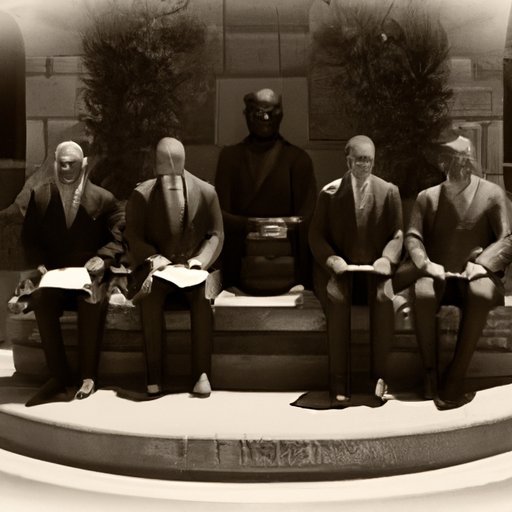Introduction
Standardized testing is a form of assessment that involves measuring student performance in academic skills using tests with a consistent format, content, and scoring system. This type of evaluation has been used for decades to measure student progress and assess their mastery of certain topics. But who invented these tests and when did they first appear? In this article, we will take an in-depth look at the history of standardized testing and the pioneers behind its invention.

A Historical Look at the Invention of Standardized Testing
The concept of standardized testing dates back centuries. Early examples of this type of assessment include the Chinese civil service exams of the Han dynasty (206 BC–220 AD), which were used to select government officials based on their knowledge and skills. Other early forms of standardized testing can be seen in the religious examinations used by medieval European universities to determine students’ aptitude for specific courses of study.
By the late 19th century, standardized testing had become more widespread in the United States. During this period, educators sought to develop a more uniform method of assessing student performance in various subject areas. As a result, the first modern standardized tests were created. These tests were designed to measure a range of cognitive abilities, such as problem solving and critical thinking.
Exploring the Pioneers Behind Standardized Testing
The invention of standardized testing was largely due to the efforts of several pioneering educators. William T. Harris, who served as the U.S. Commissioner of Education from 1889 to 1906, is credited with the idea of using a single test to measure student achievement in multiple subjects. He believed that “a single, reliable measure of individual ability should be provided.”
In 1905, Alfred Binet developed the first intelligence test, which was used to identify children with learning disabilities. This test was later adapted by Henry Herbert Goddard and Lewis M. Terman, who developed the Stanford-Binet Intelligence Scale, which is still in use today. Other notable figures who contributed to the development of standardized testing include Edward Thorndike, Stanley Hall, and Arthur S. Otis.
The Evolution of Standardized Testing Over Time
Since its inception, standardized testing has evolved significantly. Tests have become increasingly complex and are now designed to measure a variety of skills, such as reading comprehension, math proficiency, and writing ability. Additionally, technology has played an important role in the evolution of standardized tests, allowing them to be administered more quickly and accurately.
Standardized tests have also adapted to cultural and social changes. For example, in recent years, there has been a greater focus on assessing non-academic skills, such as creativity and collaboration. Additionally, accommodations have been made for students with special needs.

Spotlight on the People Who Invented Standardized Testing
William T. Harris was a major proponent of standardized testing and is considered one of its primary inventors. He argued that “the true object of education is not to teach facts, but to give power to think, to judge, and to act.” Harris’s ideas laid the foundation for the modern standardized testing movement.
Alfred Binet is best known for developing the first intelligence test. His work helped to revolutionize the way in which children with learning disabilities were identified and treated. Additionally, his research paved the way for the development of the Stanford-Binet Intelligence Scale.
Henry Herbert Goddard and Lewis M. Terman are credited with adapting Binet’s intelligence test for use in the United States. Their work resulted in the creation of the Stanford-Binet Intelligence Scale, which is still in use today. They both played a key role in popularizing the concept of intelligence testing.
Other notable figures who contributed to the development of standardized testing include Edward Thorndike, Stanley Hall, and Arthur S. Otis. Their work helped to advance the field of educational measurement and establish standardized tests as a reliable tool for assessing student performance.

Tracking the Impact of Standardized Testing from its Inception
Standardized testing has had both positive and negative impacts on education. On the positive side, these tests have allowed educators to measure student progress more accurately and objectively. They have also provided a consistent way to compare student performance across different schools and districts.
On the negative side, standardized tests have been criticized for placing too much emphasis on memorization and rote learning. Additionally, they can create an environment of high stakes testing and put undue pressure on students and teachers. Finally, some argue that these tests are not always an accurate measure of a student’s knowledge or ability.
Despite these criticisms, standardized tests remain a widely used tool for assessing student performance. However, there is still room for improvement. For example, tests could be designed to better reflect the skills and knowledge students need in order to succeed in the 21st century.
Conclusion
Standardized testing has been around for centuries and has evolved significantly over time. Its invention was largely due to the work of several pioneering educators, including William T. Harris, Alfred Binet, Henry Herbert Goddard, and Lewis M. Terman. While standardized tests have had both positive and negative impacts on education, there is still room for improvement in terms of design and content.
Overall, standardized testing has played an important role in assessing student performance and helping educators make informed decisions about curriculum and instruction. As the field of educational measurement continues to evolve, it is important to remember the people who pioneered this type of assessment.
(Note: Is this article not meeting your expectations? Do you have knowledge or insights to share? Unlock new opportunities and expand your reach by joining our authors team. Click Registration to join us and share your expertise with our readers.)
